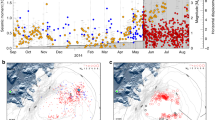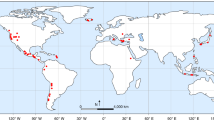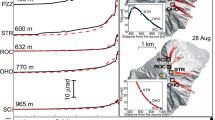Abstract
Super-eruptions are extremely rare events. Indeed, the global frequency of explosive volcanic eruptions is inversely proportional to the volume of magma released in a single event1,2. The rate of magma supply, mechanical properties of the crust and magma, and tectonic regime are known to play a role in controlling eruption frequency and magnitude3,4,5,6,7, but their relative contributions have not been quantified. Here we use a thermomechanical numerical model of magma injection into Earth’s crust and Monte Carlo simulations to explore the factors controlling the recurrence rates of eruptions of different magnitudes. We find that the rate of magma supply to the upper crust controls the volume of a single eruption. The time interval between magma injections into the subvolcanic reservoir, at a constant magma-supply rate, determines the duration of the magmatic activity that precedes eruptions. Our simulations reproduce the observed relationship between eruption volume and magma chamber residence times and replicate the observed correlation between erupted volumes and caldera dimensions8,9. We also find that magma buoyancy is key to triggering super-eruptions, whereas pressurization associated with magma injection is responsible for relatively small and frequent eruptions. Our findings help improve our ability to decipher the long-term activity patterns of volcanic systems.
This is a preview of subscription content, access via your institution
Access options
Subscribe to this journal
Receive 12 print issues and online access
$259.00 per year
only $21.58 per issue
Buy this article
- Purchase on Springer Link
- Instant access to full article PDF
Prices may be subject to local taxes which are calculated during checkout



Similar content being viewed by others
References
Mason, B. G., Pyle, D. M. & Oppenheimer, C. The size and frequency of the largest explosive eruptions on Earth. Bull. Volcanol. 66, 735–748 (2004).
Deligne, N. I., Coles, S. G. & Sparks, R. S. J. Recurrence rates of large explosive volcanic eruptions. J. Geophys. Res. 115, B06203 (2010).
Jellinek, A. M. & DePaolo, D. J. A model for the origin of large silicic magma chambers: Precursors of caldera-forming eruptions. Bull. Volcanol. 65, 363–381 (2003).
De Silva, S. L. & Gosnold, W. D. Episodic construction of batholiths: Insights from the spatiotemporal development of an ignimbrite flare-up. J. Volcanol. Geotherm. Res. 167, 320–335 (2007).
Annen, C. From plutons to magma chambers: Thermal constraints on the accumulation of eruptible silicic magma in the upper crust. Earth Planet. Sci. Lett. 284, 409–416 (2009).
Gregg, P. M., de Silva, S. L., Grosfils, E. B. & Parmigiani, J. P. Catastrophic caldera-forming eruptions: Thermomechanics and implications for eruption triggering and maximum caldera dimensions on Earth. J. Volcanol. Geotherm. Res. 241–242, 1–12 (2012).
Karlstrom, L., Rudolph, M. L. & Manga, M. Caldera size modulated by the yield stress within a crystal-rich magma reservoir. Nature Geosci. 5, 402–405 (2012).
Costa, F. Developments in Volcanology Vol. 10, 1–55 (Elsevier, 2008).
Martı´, J., Geyer, A. & Folch, A. Development in Volcanology Vol. 10, 233–283 (Elsevier, 2008).
Blundy, J. & Cashman, K. Ascent-driven crystallisation of dacite magmas at Mount St Helens, 1980–1986. Contrib. Mineral Petrol. 140, 631–650 (2001).
Marsh, B. D. On the crystallinity, probability of occurrence, and rheology of lava and magma. Contrib. Mineral Petrol. 78, 85–98 (1981).
Caricchi, L. et al. Non-Newtonian rheology of crystal-bearing magmas and implications for magma ascent dynamics. Earth Planet. Sci. Lett. 264, 402–419 (2007).
Glazner, A. F., Bartley, J. M., Coleman, D. S., Gray, W. & Taylor, R. Z. Are plutons assembled over millions of years by amalgamation from small magma chambers? Gsa Today 14, 4–11 (2004).
De Saint-Blanquat, et al. Multiscale magmatic cyclicity, duration of pluton construction, and the paradoxical relationship between tectonism and plutonism in continental arcs. Tectonophysics 500, 20–33 (2011).
Michaut, C. & Jaupart, C. Ultra-rapid formation of large volumes of evolved magma. Earth Planet. Sc. Lett. 250, 38–52 (2006).
Karlstrom, L., Dufek, J. & Manga, M. Magma chamber stability in arc and continental crust. J. Volcanol. Geotherm. Res. 190, 249–270 (2010).
Gudmundsson, A. Magma chambers: Formation, local stresses, excess pressures, and compartments. J. Volcanol. Geotherm. Res. 237–238, 19–41 (2012).
Menand, T. Physical controls and depth of emplacement of igneous bodies: A review. Tectonophysics 500, 11–19 (2011).
Ruff, L. J. Dynamic stress drop of recent earthquakes: Variations within subduction zones. Pure Appl. Geophys. 154, 409–431 (1999).
Geyer, A., Folch, A. & Martı´, J. Relationship between caldera collapse and magma chamber withdrawal: An experimental approach. J. Volcanol. Geotherm. Res. 157, 375–386 (2006).
Bacon, C. R. & Lanphere, M. A. Eruptive history and geochronology of Mount Mazama and the Crater Lake region, Oregon. Geol. Soc. Am. Bull. 118, 1331–1359 (2006).
Klemetti, E. W., Deering, C. D., Cooper, K. M. & Roeske, S. M. Magmatic perturbations in the Okataina Volcanic Complex, New Zealand at thousand-year timescales recorded in single zircon crystals. Earth Planet. Sci. Lett. 305, 185–194 (2011).
Stelten, M. E. & Cooper, K. M. Constraints on the nature of the subvolcanic reservoir at South Sister volcano, Oregon from U-series dating combined with sub-crystal trace-element analysis of plagioclase and zircon. Earth Planet. Sci. Lett. 313–314, 1–11 (2012).
Self, S., Gertisser, R., Thordarson, T., Rampino, M. R. & Wolff, J. A. Magma volume, volatile emissions, and stratospheric aerosols from the 1815 eruption of Tambora. Geophys. Res. Lett. 31, L20608 (2004).
Newhall, C. G. & Punongbayan, S. A. Fire and Mud: Eruptions and lahars of Mount Pinatubo, Philippines (Univ. Washington Press, 1996).
Hawkesworth, C., George, R., Turner, S. & Zellmer, G. Time scales of magmatic processes. Earth Planet. Sci. Lett. 218, 1–16 (2004).
Piwinski, A. J. & Wyllie, P. J. Experimental studies of igneous rock series. Felsic body suite from needle point pluton, Wallowa-Batholith, Oregon. J. Geol. 78, 52–76 (1970).
Tait, S., Jaupart, C. & Vergniolle, S. Pressure, gas content and eruption periodicity of a shallow, crystallising magma chamber. Earth Planet. Sci. Lett. 92, 107–123 (1989).
Pitzer, K. S. & Sterner, S. M. Equations of state valid continuously from zero to extreme pressures for H2O and CO2 . J. Chem. Phys. 101, 3111–3116 (1994).
Acknowledgements
This work was financially supported by a NERC fellowship (NE/G012946/1) to L.C. and an ERC Advanced Grant CRITMAG and Royal Society Wolfson Research Merit Award to J.B. C.A. was financially supported through ERC Advanced Grant VOLDIES to S. Sparks, who we also thank for comments on an earlier version of the manuscript. The review of M. Jellinek significantly improved the manuscript.
Author information
Authors and Affiliations
Contributions
All authors contributed to the study. L.C. carried out the mechanical modelling, the Monte Carlo simulations, wrote the first draft of the manuscript and prepared the figures.
Corresponding author
Ethics declarations
Competing interests
The authors declare no competing financial interests.
Supplementary information
Supplementary Information
Supplementary Information (PDF 1212 kb)
Rights and permissions
About this article
Cite this article
Caricchi, L., Annen, C., Blundy, J. et al. Frequency and magnitude of volcanic eruptions controlled by magma injection and buoyancy. Nature Geosci 7, 126–130 (2014). https://doi.org/10.1038/ngeo2041
Received:
Accepted:
Published:
Issue Date:
DOI: https://doi.org/10.1038/ngeo2041
This article is cited by
-
Rapid accumulation and ascent precedes caldera forming eruption of low viscosity magma
Contributions to Mineralogy and Petrology (2024)
-
Magmatic-tectonic response of the South China Craton to the Paleo-Pacific subduction during the Triassic: a new viewpoint based on Well NK-1
Journal of Oceanology and Limnology (2024)
-
Geochemical variability as an indicator for large magnitude eruptions in volcanic arcs
Scientific Reports (2022)
-
Experimental measurements of the viscosity and melt structure of alkali basalts at high pressure and temperature
Scientific Reports (2022)
-
Eruption at basaltic calderas forecast by magma flow rate
Nature Geoscience (2022)



